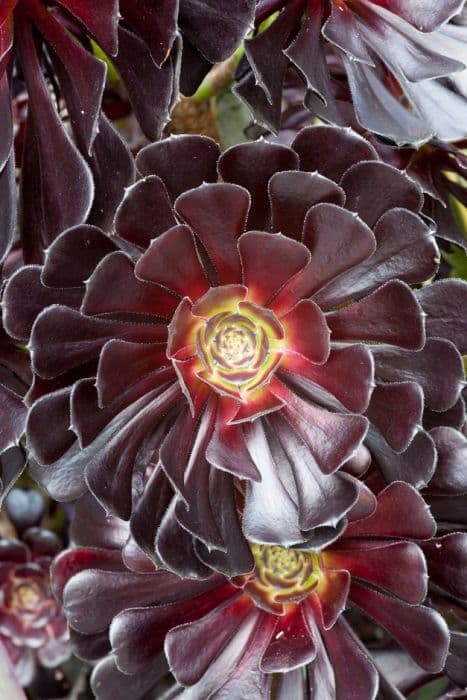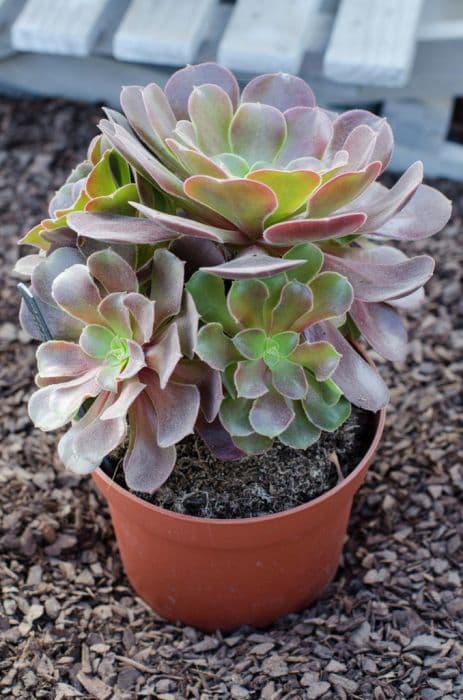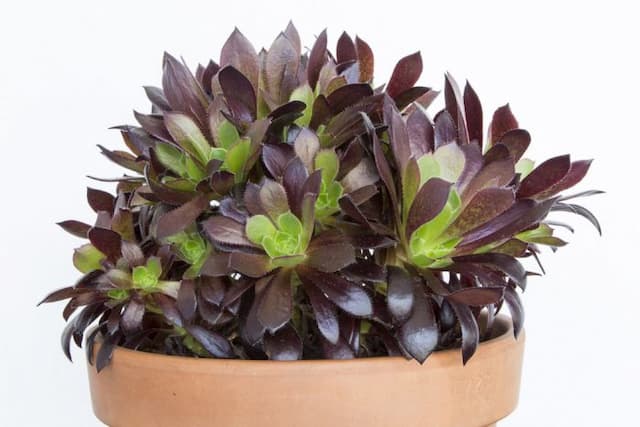Sunburst Aeonium Aeonium 'Sunburst' (v)

ABOUT
Aeonium 'Sunburst' is a strikingly ornamental plant with a rosette-like growth pattern, featuring vibrant foliage that makes it a standout in any succulent collection. The leaves are arranged in a spiral fashion, creating a mesmerizing pattern reminiscent of a burst of sunlight. Each leaf is broad and fleshy, tapering to a delicate point. The most remarkable aspect of the foliage is its coloration—an eye-catching array of creamy yellow and green variegation, with a hint of pink or coral highlights adorning the edges, especially when exposed to bright sunlight. The contrast between the creamy variegation and the deeper colors gives the plant a painted appearance, as if each leaf were carefully brushed with hues from an artist's palette. The overall impression of Aeonium 'Sunburst' is one of bold, luminous beauty that evokes the radiance of the sun. Its layered, symmetrical form adds a touch of architectural elegance to gardens, pots, or wherever it's grown.
About this plant
 Names
NamesFamily
Crassulaceae.
Synonyms
Copper Pinwheel, Sunburst Aeonium, Variegated Aeonium, Sunburst.
Common names
Aeonium 'Sunburst' (v).
 Toxicity
ToxicityTo humans
Sunburst is not known to be toxic to humans. While it is generally safe, it's advisable not to ingest any parts of the plant due to the potential risk of gastrointestinal discomfort typical of many non-edible plants.
To pets
Sunburst is not considered toxic to pets. It is unlikely to cause harm if pets nibble on it, but ingestion of plant material could potentially result in mild gastrointestinal upset, simply because it is not part of their normal diet.
 Characteristics
CharacteristicsLife cycle
Perennials
Foliage type
Evergreen
Color of leaves
Variegated
Height
2 feet (60 cm)
Spread
2 feet (60 cm)
Plant type
Succulent
Hardiness zones
9
Native area
Canary Islands
Benefits
 General Benefits
General Benefits- Decorative Appeal: 'Sunburst' has variegated leaves with a striking appearance, adding aesthetic value to gardens and homes.
- Drought Tolerant: It requires minimal watering, making it ideal for xeriscaping and water-wise gardens.
- Easy to Care For: This low-maintenance plant is suitable for gardeners of all levels, including beginners.
- Attracts Pollinators: It can attract bees and butterflies, which are beneficial for pollinating gardens.
 Medical Properties
Medical PropertiesThis plant is not used for medical purposes.
 Air-purifying Qualities
Air-purifying QualitiesThis plant is not specifically known for air purifying qualities.
 Other Uses
Other Uses- Aeonium 'Sunburst' can be used for educational purposes in botany and horticulture classes to demonstrate succulent care and propagation techniques.
- This plant serves as an interesting subject for photographers and artists, who may appreciate capturing its intricate patterns and vibrant colors.
- Due to its unique appearance, it can be used in themed landscaping projects to evoke a Mediterranean or tropical ambiance.
- Aeonium 'Sunburst' can contribute to reducing noise pollution when planted in dense arrangements in urban gardens.
- It can be gifted as a living ornament for special occasions, symbolizing growth and resilience.
- The leaves can be used in crafting, for instance, by imprinting them into clay or cement for decorative stepping stones or patterns.
- The plant can be potted in creative DIY containers, like upcycled items, offering a way to teach sustainability and reuse.
- For culinary enthusiasts, though not commonly consumed, its fleshy leaves could possibly be explored in avant-garde cuisine under expert advice for edible succulents.
- The contrasting colors of Aeonium 'Sunburst' can be used as a natural palette inspiration for designers in fashion and home decor.
- It can be used as a natural barrier for certain pests in gardens due to its thick and waxy leaves which are less appealing to common garden pests.
Interesting Facts
 Feng Shui
Feng ShuiThe Aeonium 'Sunburst' is not used in Feng Shui practice.
 Zodiac Sign Compitability
Zodiac Sign CompitabilityThe Aeonium 'Sunburst' is not used in astrology practice.
 Plant Symbolism
Plant Symbolism- Radiant Beauty: The 'Sunburst' part of the Aeonium 'Sunburst' name suggests a burst of radiance or beauty, reflecting the plant's stunning appearance with variegated leaves that resemble bursts of sunlight.
- Vitality: Aeoniums, known for their rosette shapes and growth during the winter, symbolize vitality and the ability to thrive in less than ideal conditions.
- Resilience: Native to the Canary Islands, Aeonium 'Sunburst' is adapted to survive with minimal water, representing toughness and the ability to endure challenging situations.
- Transformation: This plant can change color based on sun exposure, symbolizing adaptability and personal growth.
 Water
WaterThe Sunburst Aeonium should be watered thoroughly once the soil has become completely dry, typically every 7 to 10 days during active growth in the spring and fall. During the summer dormancy period, water sparingly, only once every 2-3 weeks, to prevent root rot. In the winter, watering frequency should be reduced further due to cooler temperatures and reduced evaporation rates. When watering, it is crucial to avoid getting water on the rosettes as this can cause rot. Pour water directly onto the soil until it begins to run out of the bottom of the pot, which might take approximately 8 to 16 ounces for a small to medium-sized pot.
 Light
LightSunburst Aeoniums thrive in bright but indirect sunlight. They prefer a spot that receives partial sun to light shade, ideally getting morning light and protection from the intense afternoon sun that could scorch their leaves. An east or west-facing window provides optimal light conditions indoors, while a shaded spot outside that gets dappled sunlight is perfect for growth.
 Temperature
TemperatureSunburst Aeonium prefers a temperature range between 40°F and 80°F to thrive. It can withstand minimum temperatures of around 40°F but should be protected from frost. The ideal temperature range for this succulent is between 65°F and 75°F. Extreme temperatures that fall outside of these ranges may negatively impact the health of the Aeonium.
 Pruning
PruningPruning Sunburst Aeonium is primarily done to remove any damaged or dying leaves and to encourage a more compact and bushier growth habit. It should be pruned in the spring or early summer, just before the plant's active growing period. Pruning can be done every year or as needed when you notice damaged parts or if the plant becomes leggy.
 Cleaning
CleaningAs needed
 Soil
SoilSunburst Aeonium thrives in a well-draining soil mix composed of one-third potting soil, one-third perlite or coarse sand, and one-third organic matter like peat or coir. The ideal soil pH should be mildly acidic to neutral, between 6.0 and 7.0.
 Repotting
RepottingSunburst Aeonium should be repotted every two to three years or when it becomes rootbound. The repotting is best done during its dormancy period, which is in the summer for Aeoniums.
 Humidity & Misting
Humidity & MistingSunburst Aeonium prefers low to moderate humidity levels, typical of arid environments, as it is susceptible to rot in high humidity conditions.
 Suitable locations
Suitable locationsIndoor
Place in bright, indirect light and ensure good ventilation.
Outdoor
Needs full to partial sun, shelter from harsh midday rays.
Hardiness zone
9-11 USDA
 Life cycle
Life cycleAeonium 'Sunburst' (commonly known as Sunburst Aeonium) begins its life when a seed germinates in well-draining soil and adequate sunlight. The seedling stage is characterized by the emergence of a small rosette of variegated leaves, which expands as the plant enters the vegetative stage. During this stage, the rosette grows larger and may produce additional offsets (baby plants) that can be separated to propagate new individuals. The plant continues to mature and can enter a dormant phase during hot and dry periods, where growth slows significantly. After several years, it reaches the flowering stage, producing a tall inflorescence with yellow, star-shaped flowers, after which the main rosette usually dies. This cycle is perpetuated by the seeds from the flowers or the growth of offsets that replace the parent rosette.
 Propogation
PropogationPropogation time
Spring-Early Summer
Propogation: The Aeonium 'Sunburst', also known as Copper Pinwheel, is most commonly propagated through stem cuttings, especially during its active growth period in spring or early summer. To do this, a healthy stem is selected and cut with a sharp, sterilized knife or pair of scissors, leaving a stem length of about 2 to 4 inches (5 to 10 centimeters). The cut end should be allowed to callous over for a few days to prevent rotting when planted. After the end has healed, the cutting can be placed in well-draining soil. Care should be taken to keep the soil lightly moist, and the cutting should be kept in bright, indirect sunlight until new growth indicates that rooting has occurred.









